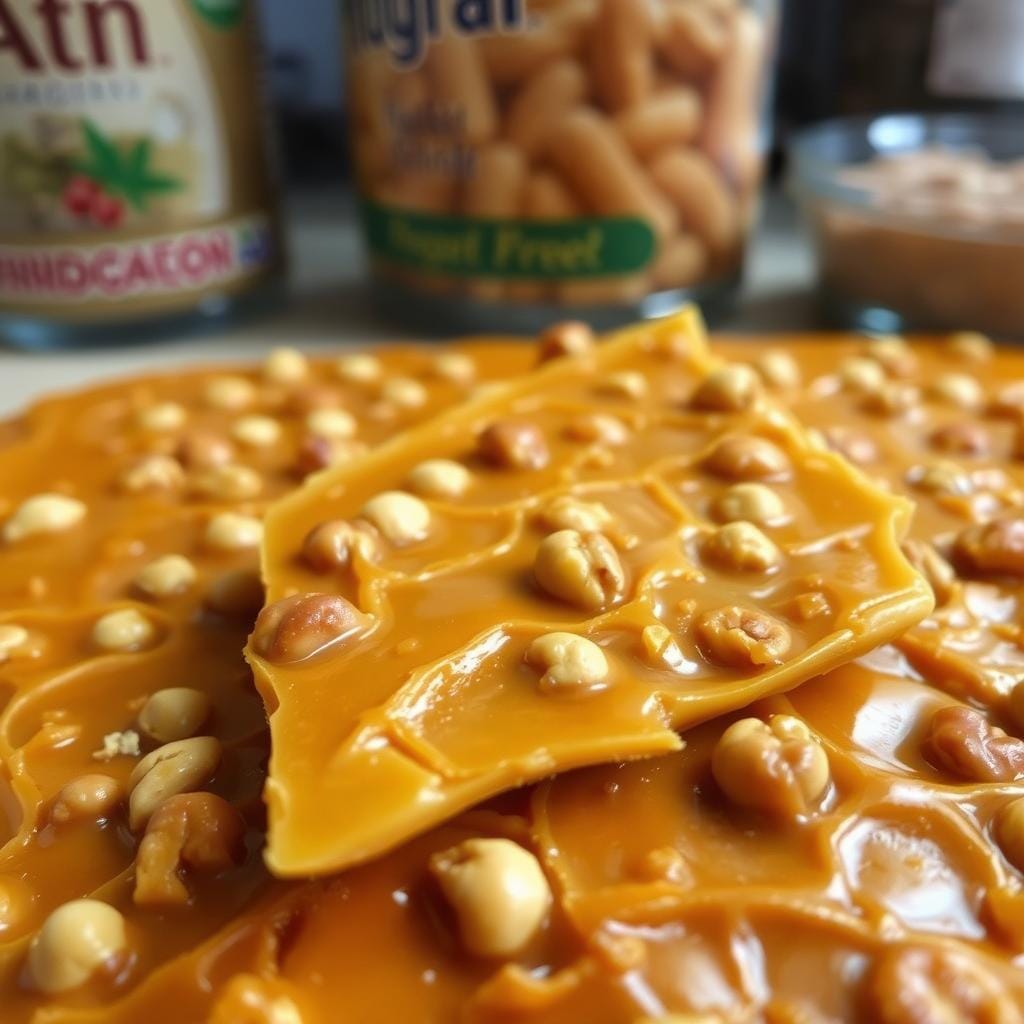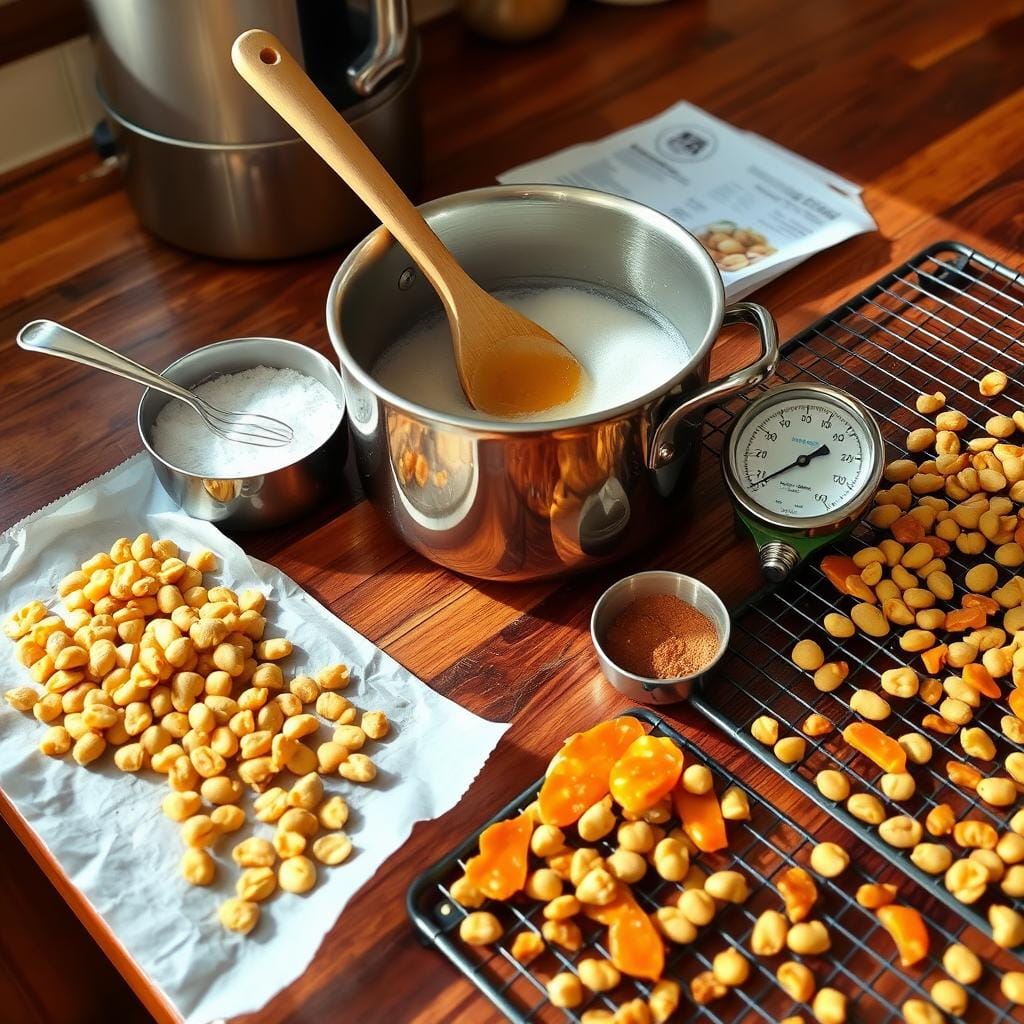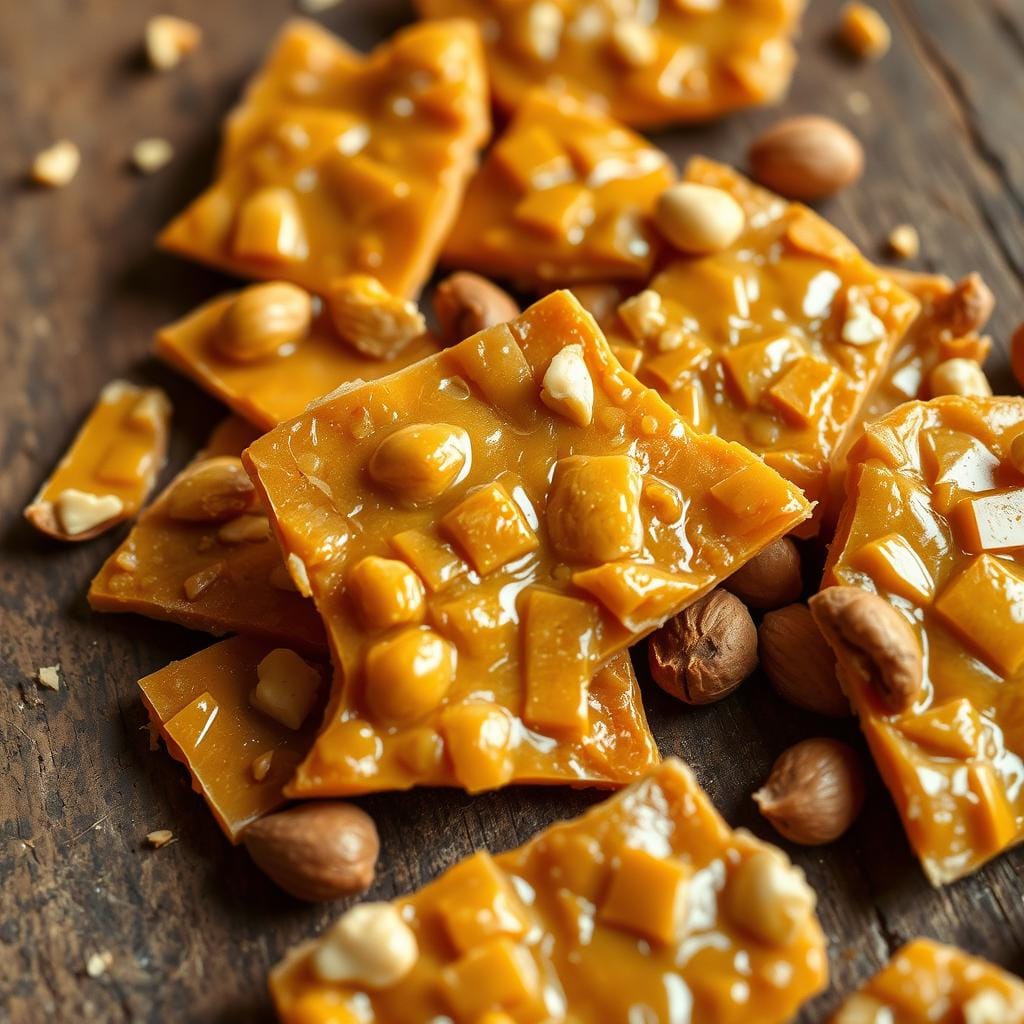What causes peanut brittle not to harden? As a passionate home baker, I’ve faced the frustration of caramel not setting properly. But don’t worry, fellow candy enthusiasts! Let’s explore the science behind peanut brittle hardening and the common issues that can prevent it from achieving that perfect crunch.
Key Takeaways
- Understand the chemical reactions and sugar crystallization involved in creating hard peanut brittle
- Identify the role of temperature in achieving the perfect texture
- Troubleshoot common issues like humidity, incorrect temperature readings, and improper ingredient ratios
- Discover the best practices for controlling temperature and cooling methods
- Learn how to test candy hardness and implement proper storage techniques
Understanding the Science Behind Peanut Brittle Hardening
Making perfect peanut brittle is an art that needs science knowledge. It involves chemical reactions and sugar crystallization. These factors affect the texture and hardness of the confection.
Chemical Reactions During Cooking
When you heat the peanut brittle mix, many chemical reactions happen. Sugars turn golden and add flavor. At the same time, peanut proteins react, improving the aroma and taste.
The Role of Sugar Crystallization
Sugar crystallization is key to peanut brittle’s crunch. As the syrup cools, sugar molecules form crystals. This process is vital for the peanut brittle texture problems and cooking techniques for hard peanut brittle.
Temperature’s Impact on Texture
The cooking and cooling temperature is very important. The right temperature ensures sugar caramelizes well. Quick cooling helps crystals form fast, giving the crunchy texture.
Knowing the science behind peanut brittle hardening helps solve peanut brittle texture problems. It also helps master cooking techniques for hard peanut brittle. With this knowledge, you’ll make amazing peanut brittle every time.

Essential Equipment for Perfect Peanut Brittle
Making perfect peanut brittle needs the right tools. It’s not just about mixing ingredients. The right setup is key for that hard, crisp texture. Let’s look at the must-have equipment for making great peanut brittle.
A candy thermometer is a must. It lets you check the sugar syrup’s temperature precisely. This ensures it’s at the perfect stage for hardening. Get a good thermometer that goes up to 300°F (149°C) or more.
A heavy-bottomed saucepan or pot is also crucial. Its thick base spreads heat evenly, avoiding hot spots. This prevents the sugar from burning. Pick a pot that’s at least 2 to 3 quarts (1.9 to 2.8 liters) big to hold the mixture as it cooks.
- Candy thermometer
- Heavy-bottomed saucepan or pot
- Wooden spoon or heatproof spatula
- Baking sheet or parchment paper
- Cooling rack
You’ll also need a wooden spoon or heatproof spatula for stirring. This keeps the heat even and prevents burning. A baking sheet or parchment paper is key for spreading the hot mixture. It also helps it cool and harden. Lastly, a cooling rack is useful for cooling the brittle completely before breaking it.
With these tools, you’ll make perfect peanut brittle every time. The right equipment is vital for solving candy making issues and following peanut brittle hardening tips.

What Causes Peanut Brittle Not to Harden?
Making peanut brittle that’s hard as a rock can be tough. If it turns out soft and chewy instead, there are a few reasons why. Knowing what makes peanut brittle soft is key to making it perfect.
Humidity and Moisture Issues
Too much moisture in the air or ingredients can make peanut brittle soft. It needs the right mix of sugar, fat, and water to snap. If there’s too much moisture, it messes up the sugar’s crystallization, leaving it soft and sticky.
Incorrect Temperature Reading
Getting the temperature just right is crucial for peanut brittle. If your thermometer is off, even a little, the sugar won’t get hot enough. Always check your thermometer to get the best results.
Wrong Sugar-to-Butter Ratio
The sugar-to-butter ratio is important for the texture of peanut brittle. Too much butter can stop the sugar from forming crystals, making it chewy. Stick to the recipe’s measurements for the perfect crunch.
Knowing these common mistakes helps you fix your peanut brittle recipe. With practice and attention to detail, you’ll make hard, crunchy peanut brittle every time.
The Importance of Proper Temperature Control
To make perfect cooking techniques for hard peanut brittle, you need to control the temperature well. The right temperature is key to getting the right texture and hardness. Learning to control the temperature helps solve peanut brittle hardening problems and makes your brittle crunchy and delicious.
The best temperature for cooking peanut brittle is between 300°F and 310°F (150°C and 155°C). Keeping this temperature is important. If it’s too low, your brittle will be soft. If it’s too high, it will burn and taste bitter.
- Use a good candy thermometer to keep the temperature right.
- Adjust the heat to keep the temperature steady while cooking.
- Watch out for things like humidity and air movement, as they can mess with the temperature and make the brittle harden unevenly.
| Temperature Range | Texture Result |
|---|---|
| Below 300°F (150°C) | Soft, chewy peanut brittle |
| 300°F – 310°F (150°C – 155°C) | Ideal, crunchy peanut brittle |
| Above 310°F (155°C) | Burnt, bitter peanut brittle |
Understanding the need for proper temperature control is key. By following these tips, you’ll make cooking techniques for hard peanut brittle that are always hard, crisp, and tasty. This way, you’ll avoid any peanut brittle hardening problems you’ve had before.
Common Ingredients That Affect Brittleness
Making the perfect peanut brittle is all about finding the right mix of ingredients. Knowing how each one affects the texture is key. From sugar types to butter and corn syrup, let’s look at what makes peanut brittle crunchy.
Sugar Types and Their Effects
The sugar you choose greatly impacts peanut brittle’s texture. White granulated sugar makes it crisp and brittle. But mixing in brown sugar or honey can make it chewier. Finding the right mix is essential for the perfect texture.
Butter vs. Margarine Impact
The choice between butter and margarine significantly affects peanut brittle’s texture. While butter adds richness and a softer feel, margarine, with its lower fat content, creates a crunchier result. Experimenting with the butter-to-margarine ratio can help you perfect your recipe.
Corn Syrup’s Role
Corn syrup is often used in peanut brittle recipes. It prevents sugar from forming crystals too fast, avoiding a grainy texture. This helps the candy stay smooth and crunchy.
Knowing how these ingredients affect peanut brittle is crucial. By trying different sugars, butter-to-margarine ratios, and corn syrup amounts, you can get the perfect crunchy texture. This is key to fixing peanut brittle consistency and addressing peanut brittle texture problems.
Troubleshooting Soft Peanut Brittle Issues
Don’t worry if your peanut brittle is soft. There are ways to fix it. Knowing why it’s soft can help you make it hard and crisp.
Insufficient cooking time or temperature is often the problem. Make sure the temperature is between 300°F to 310°F. This helps the sugar harden properly.
The sugar-to-butter ratio is also important. Too much sugar or butter can make it soft. Try using 2 cups of sugar for every 2 tablespoons of butter.
High humidity can also make peanut brittle soft. It’s best to work in a dry place. This helps the sugar crystallize better.
By fixing these common issues, you can make your peanut brittle hard and crisp. Try adjusting cooking times, ingredient ratios, and working conditions. This will help you make a delicious peanut brittle.
Best Practices for Achieving Hard Brittle
Making perfect peanut brittle is more than just a recipe. Getting the hard and crunchy texture is key. With a few important techniques, your peanut brittle will always turn out right.
Proper Stirring Techniques
Stirring the mixture gently and consistently is crucial. Don’t stir too much, as it can make the brittle soft. Use a wooden spoon to fold the mix gently. This helps distribute heat evenly and prevents hot spots.
Cooling Methods
Cooling the brittle right is key. Pour the hot mixture onto a greased baking sheet. Spread it out and let it cool slowly at room temperature. This slow cooling helps the sugar crystallize, making the brittle hard and crunchy.
Storage Solutions
Storing your peanut brittle correctly keeps it crunchy. Store it in an airtight container at room temperature. Keep it away from sunlight and moisture. Don’t refrigerate or freeze it, as this can make it soft.
By following these peanut brittle hardening tips and cooking techniques for hard peanut brittle, you’ll always get the perfect hard and crunchy peanut brittle. It will surely please your taste buds.
Weather Conditions and Their Impact
Weather can greatly affect making perfect peanut brittle. Knowing how different weather conditions impact hardening is key. This knowledge helps achieve the crunchy, shatter-resistant texture we all love.
High humidity is a major reason why peanut brittle doesn’t harden. Moisture in the air can mess with sugar crystallization. This leads to a soft, sticky, or gooey final product. To fix this, keep an eye on humidity levels and control them. Use a dehumidifier or work in a drier area.
Temperature extremes can also cause peanut brittle hardening problems. Issues arise from sudden temperature changes or incorrect cooking temperatures. Sudden changes can mess up the sugar structure. Incorrect temperatures can prevent caramelization or undercook the candy.
| Weather Condition | Impact on Peanut Brittle | Recommended Solution |
|---|---|---|
| High Humidity | Soft, tacky, or gooey texture | Use a dehumidifier or work in a drier environment |
| Extreme Temperatures | Disrupted sugar structure, incomplete caramelization | Maintain precise temperature control, avoid sudden changes |
To get your peanut brittle to harden right, watch the weather closely. Adjust as needed. By understanding the science and how weather affects it, you’ll make the perfect peanut brittle.
Tips for Testing Candy Hardness
Getting the perfect peanut brittle texture is all about balance. Testing the candy’s hardness is key to success. There are reliable ways to check your candy’s progress and make any needed changes.
Cold Water Test Method
The cold water test is a common and effective method. It involves dropping a small candy mixture into cold water. The candy’s shape or texture in the water tells you its stage:
- Soft ball stage: The candy forms a soft, pliable ball that flattens easily.
- Hard ball stage: The candy forms a firm, malleable ball that doesn’t flatten easily.
- Crack stage: The candy forms hard, brittle shards that snap when bent.
Watching how the candy behaves in cold water helps you know if you’ve reached the right temperature. This ensures your peanut brittle hardness is just right.
Candy Thermometer Accuracy
Using a candy thermometer is also crucial. It helps with candy making issues and keeps track of the temperature. Make sure your thermometer is accurate for consistent results with your peanut brittle hardening tips.
By using the cold water test and monitoring the temperature, you’ll make perfect peanut brittle every time.
Storage and Preservation Methods
Keeping your homemade peanut brittle perfect requires careful storage and preservation. The right storage methods can help fix peanut brittle consistency and avoid peanut brittle texture problems.
For the best crunch and flavor, store your peanut brittle in an airtight container. Glass jars or tin cans are great because they keep moisture out. Don’t use plastic bags or containers, as they let air in and can make the brittle soft.
Temperature is also key. Keep your peanut brittle in a cool, dry spot, between 50°F and 70°F. High temperatures can make the sugar melt and the texture chewy instead of crisp.
To keep it fresh longer, vacuum seal your peanut brittle. This removes air and keeps it fresh, stopping moisture from ruining the texture. Stored right, your homemade peanut brittle can last several weeks to a few months.
Always check your peanut brittle for signs of spoilage, like a bad smell or softening. If it looks or smells off, it’s best to throw it away and make a new batch.
By using these storage and preservation tips, your peanut brittle will stay crisp and crunchy. This will satisfy your sweet tooth for weeks.
Conclusion
In this guide, we’ve looked into why peanut brittle doesn’t harden right. We’ve covered the science behind cooking and the importance of temperature control. This knowledge helps you make perfect, hard peanut brittle every time.
Learning how to manage humidity, check temperatures, and balance sugar and butter is key. We’ve also talked about how ingredients, storage, and weather can affect your results. This information helps you make better choices and solve problems.
Now you know what causes peanut brittle not to harden and how to fix it. With these tips, you can make delicious, crunchy peanut brittle that everyone will love. Use this knowledge to improve your baking and enjoy success in every batch.

